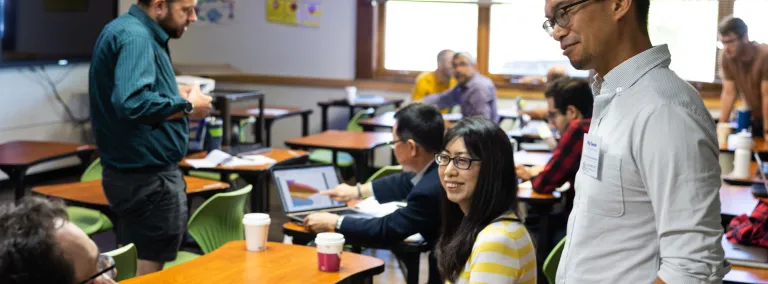SURF workshop draws leading physics theorists, experimentalists to Lead, SD
CETUP* conference invited community members to collaborate on pressing questions in the underground sciences
Particle physicists from around the world converged this summer at the Sanford Underground Research Facility (SURF) in Lead, South Dakota, to consider some of the most pressing questions in their field. The Center for Theoretical Underground Physics and Related Areas (CETUP*) conference drew nearly 70 theorists, experimentalists, and students representing 47 institutions.
SURF revived the conference, which had been held annually from 2011 through 2016, as part of the newly formed Institute for Underground Science at SURF (the Institute).
“The Institute will provide a space for intellectual communities to come together and have truly transformative conversations,” said Michelle Kane, director of the SURF Foundation. “We want to create a world-class experience for researchers and students, and CETUP* is the prototype of the programming we envision for the Institute.”
CETUP* aims to engage researchers from all areas of underground science, including physics, biology, geology, and engineering, to participate in conversations about the future of their research. This year’s conference focused on two main topics: dark matter, the missing mass that holds our Universe together, and neutrinos, ghostly particles that could be the key to understanding why matter exists at all.
Kaladi Babu, CETUP* organizer and regents professor at Oklahoma State University, spends much of his time thinking about dark matter. “We don’t know what dark matter is or what its properties are; there are hundreds of possible candidates,” Babu explained. “Theorists will come to this conference to discuss the pros and cons of these candidates, and, with the experimentalists, discuss ways to test those theories through experimentation.”
Addressing these questions requires a lot of brainpower.
“These theory calculations involve sophisticated techniques, and not everyone is an expert in all aspects of these calculations,” Babu said. “CETUP* brings people with different expertise—from early Universe cosmology to theoretical particle physics to nuclear physics—together to work on these questions.”
Unlike many conferences with back-to-back presentations and parallel breakout sessions, CETUP*’s daily schedule begins with two short talks, followed by ample time for discussion and unstructured collaboration.
“The lack of structure is a structure,” said Barbara Szczerbinska, CETUP* organizer and associate dean for academic affairs at Texas A&M University, Corpus Christi. “From the beginning, we wanted to bring people together—not in the traditional conference setting, when you have a lot of talks and little time for interactions—but in a way that creates a think tank to address what is happening now in our fields and paints the vision for what’s next.”
After the conference, scientists will further develop theories into testable predictions, which could lead to new experiments hosted at laboratories like SURF.
“CETUP* engages with the wider underground science community to support the science at SURF,” said Jaret Heise, organizer and science director at SURF. “It provides a venue where theorists can interact with experimentalists and discuss the details of these topics. It’s a very fruitful type of workshop.”
Conference sessions were held at the Lead-Deadwood Middle School. “It’s funny; you walk into a middle school classroom and see these high-level physics equations on the whiteboards,” Szczerbinska said. “The middle school was incredibly supportive, and we’re so grateful to the staff for letting us use the building.”
CETUP* also provides an opportunity for visiting researchers to interact with the local community. Attendees volunteered at Neutrino Day, SURF’s citywide science festival; answered questions at Sanford Lab Homestake Visitor Center’s “Ask A Scientist” event series; and gave presentations to visiting bus tours. A special CETUP* session was also organized with undergraduate students from Texas, Black Hills State University as well as SURF.
In 2011 through 2016, CETUP* developed a reputation as a much-needed source of collaboration and resulted in the publication of 119 scientific papers. In 2013 and 2015, CETUP* hosted the Particle Physics and Cosmology conference. When SURF announced that it would revive the workshop in 2023, there was a lot of excitement and spots filled quickly.
“We have people from South Dakota, Texas, Japan, India—this year’s attendees represent 22 countries of origin,” said Szczerbinska. “The conference creates one big community.”
SURF plans to host CETUP* annually in concert with additional Institute programming that will connect leaders in physics, biology, geology, and engineering and ignite pivotal conversations about the future of underground science.
